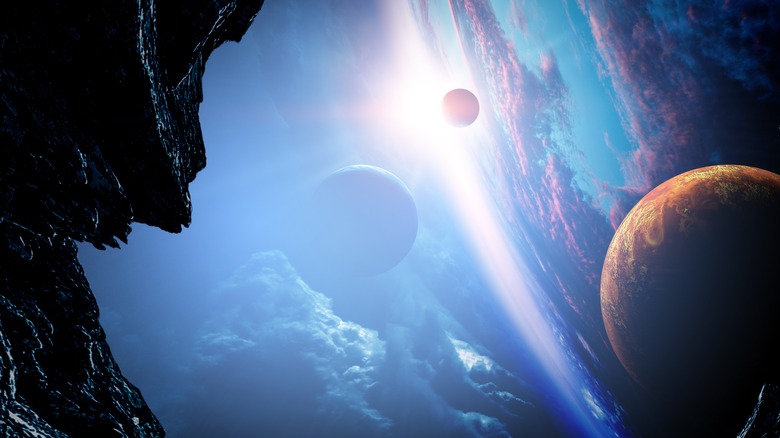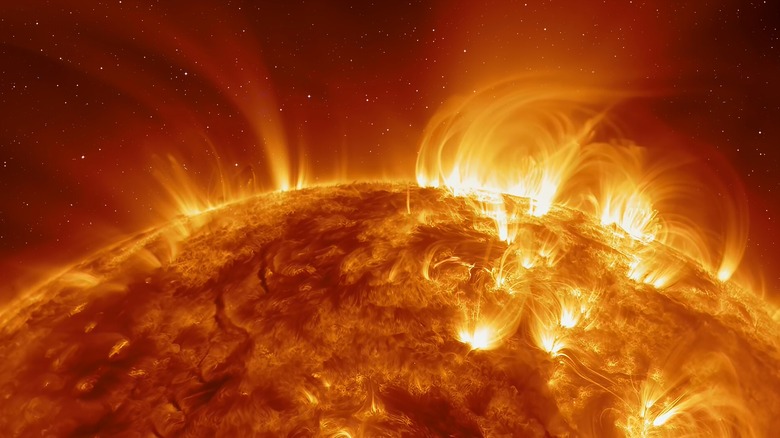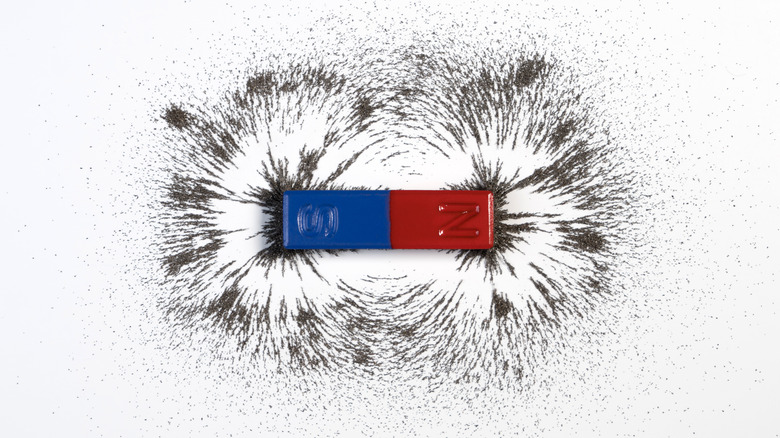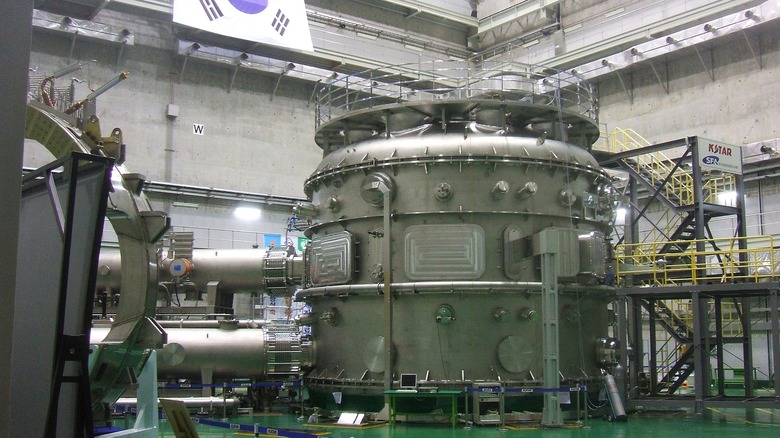How New Scientific Developments May Make Nuclear Fusion A Reality
Here's a pretty clear choice for everyone: A clean, bright, beautiful future full of cheap, nigh-limitless energy with zero nuclear waste and almost no CO2 emissions, or a filthy hellscape choked by the bilge of fossil fuels jettisoning waste into the eternally blackened sky of an Earth brutalized beyond recovery. A little exaggerated? Maybe. But now it's easier to envision what's actually at stake when we talk about "clean energy," specifically the cleanest source of them all: nuclear fusion.
Nuclear fusion, like its cousin nuclear fission, has been on the table as an energy source since the 1950s, as EUROfusion says. But while fusion never got off the ground, fission has already seen the light of day. This is why you might recognize the little nuclear waste logo that looks like a three-bladed black fan on a yellow background — a trefoil — from barrels of radioactive waste, warning signs on chain link fences, or cartoons with ninja turtles (the BBC has details). Sadly enough, fission got a head start on fusion because of warfare, particularly the engineering know-how necessary to change theoretical physics into bombs capable of destroying Hiroshima and Nagasaki at the end of World War II. The Manhattan Project from 1938 to 1939 was at the heart of this development, as the U.S. Department of Energy explains.
And now? As New Scientist describes, recent tests at Seoul National University in South Korea are starting to make nuclear fusion a puzzle of engineering, not physics.
Made of the stuff of stars
What is nuclear fusion, exactly? It's right in the name: fusion. Nuclear fusion fuses, or combines, the nuclei of atoms. Nuclear fission, by contrast, separates nuclei. Nuclear fission — "splitting the atom," as it's been called — produces the kind of nuclear energy that yields 13.5% of the world's total energy supply, as New Scientist cites. It also produces the world-ending power of atomic bombs, as the Atomic Heritage Foundation details. And so humanity gets its perfect moral articulation tool.
Nuclear fusion and fission happen on their own in nature, but we experience fusion on a daily basis. After all, it's the reason we've got that big ball of light in the sky that gives us heat and life. Fusion is what happens inside stars — it's the reason they burn. A star is so massive, and its gravity so strong, that it quite literally squeezes atoms together until their cores fuse. Over time, as ThoughtCo. outlines, this causes different compositions of atoms to form. What begins as hydrogen becomes helium after 10 million years, carbon after that, and then oxygen, neon, magnesium, and so forth. Iron is the final and heaviest element. This whole process is called "stellar nucleosynthesis."
So any time we see these elements on Earth in your body, food, phone, etc.? It got there because stars died, exploded, and sent all those fused elements zipping through the cosmos.
Recreating the sun on Earth
In concept, nuclear fusion testing sounds like science fiction, and centers on a pretty outlandish idea: recreating the power of the sun here on Earth. But that's exactly what it takes for us humans to do what a star does on its own. This is also why engineering is still catching up to theory, because you could imagine that this task isn't exactly what we call easy.
Nuclear fusion in stars wasn't even understood until about 100 years ago. As EUROfusion explains, British astrophysicist Arthur Eddington first suggested that stars get their power by fusing hydrogen into helium — the first step of stellar nucleosynthesis that eventually transmutes elements into iron, as cited on ThoughtCo. Eddington published his research in his 1920 paper "Internal Constitution of the Stars," currently available on sites like JSTOR. From there, physicists Robert d'Escourt Atkinson and Fritz Houtermans crunched the numbers, and by 1934 actual lab experiments were conducted showing that nuclear fusion devices were feasible.
This is when things got complicated, but not for reasons the reader would expect. Advances in fusion slowed down through the early 1950s because world leaders, particularly in the U.S., U.K., and U.S.S.R., kept their research hush-hush and separate from each other, as LPP Fusion explains. It was only after they realized that nuclear fusion couldn't be leveraged into weapons like A-bombs that the international community started to collaborate. The first major breakthrough came with the Soviet "tokamak," a magnetic confinement device.
Magnetic control of plasma
Even though a "magnetic confinement device" sounds like some technobabble from "Star Trek," it's actually real. It's this tech that's been the main stumbling block moving forward with nuclear fusion, and it's over this tech that recent tests at Seoul National University have demonstrated new mastery.
Magnetic confinement devices are part of nuclear fusion reactors. As EUROfusion states, they exist to contain plasma within a specified space, which is critical to the whole nuclear fusion process. Plasma is a type of superhot, charged gas that needs to be kept away from the walls of a reactor. If it touches the walls, it cools down too quickly, and fusion reactions can't be sustained, per New Scientist. As plasma stays isolated, it gets hotter and hotter — hot enough to reach "ignition," as the World Nuclear Association describes. At this point, fusion reactions will be self-sustaining and continue on their own; we've just go to keep feeding the reactor particular materials like deuterium (D) or tritium (T), isotopes (variants) of hydrogen (H). And since plasma is charged, it can be directed or confined using magnetic fields, as Live Science outlines. This is why magnetic containment devices are so critical.
When plasma is stable and ignition is achieved, a nuclear fusion reactor can produce energy four times greater than that of a nuclear fission reactor, as the World Nuclear Association says. This kind of output requires a tremendously pressurized space to keep the reactor in order.
Stability at 100 million degrees Celsius
The new nuclear fusion test in question comes from the Korea Superconducting Tokamak Advanced Research (KSTAR) device at Seoul National University in South Korea. Lead researcher Yong-Su Na and his team tried something different, and kept their plasma density very low, as New Scientist explains. Plasma, by itself, is like a blob of water or gas that doesn't have any rules about the shape it needs to take, as Live Science says. This is why it needs magnetic fields — either in a lab or created by a star — to give it its form. And so, Na used a modified "internal transport barrier" (ITB) to create high pressure in the core of the plasma, and keep the exterior cooler. Other strategies include creating what's called an "edge transport barrier" (ETB) to "sculpt" plasma and stop it from touching interior reactor walls.
And what's the result of all this effort, time, expense, intellect, expertise, and so forth? Na and his team created a stable nuclear fusion reaction for a full 30 seconds, at 100 million degrees Celsius. For comparison, the core of our sun is 15 million degrees Celsius (per Space). Thirty seconds might not sound like a long time, but it signifies something huge: From this point, improvements are only a matter of scaling up and applying the lessons learned in the present to future, bigger, sturdier, more robust reactors. At that point, we've got a real shot at having a fully self-sustaining nuclear fusion reactor.
The possibility of a clean future
The reader might well ask, "If a nuclear reactor is over six times the temperature of the sun, why didn't the nuclear fusion test just, I don't know, incinerate the world?" For that, we turn to tungsten, as Oak Ridge National Laboratory explains. Tungsten components, combined with an advanced exhaust system that's ultimately the same kind of system you'd find in a tried-and-true car, maintain temperature in a fusion reactor, as Popular Mechanics outlines. Nuclear fusion is therefore not only clean and produces next to zero impact on the environment, it's completely safe. It could never cause a disaster like Chernobyl because fusion reactions require constant fuel. If there are any problems, folks can just switch off the flow.
Of course, the recent success of KSTAR at Seoul National University isn't the only current foray into nuclear fusion. The ITER reactor under construction in Saint-Paul-lez-Durance, France can leverage the lessons of KSTAR to create what will be the biggest and most viable nuclear fusion reactor in the world when completed, as the ITER website describes. Some 28 nations are involved in ITER's construction, including China, the entire EU, Switzerland, India, Japan, Korea, Russia, and the United States. Meanwhile, the U.K. is also trying its hand at building its own reactor in Nottinghamshire, as iNews says.
All of this should give heart to those despairing about global warming. There is at least a chance to keep the planet bright, clean, and beautiful for us and the future.





